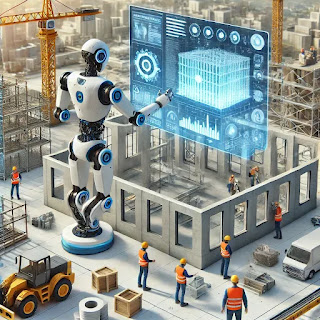3D Printing and Modular Construction in Civil Engineering
Introduction
The construction industry is evolving rapidly, integrating modern technologies to improve efficiency, sustainability, and cost-effectiveness. Among the most transformative advancements are 3D printing and modular construction. These technologies are redefining traditional building processes by reducing waste, speeding up construction times, and offering innovative design possibilities. This blog explores how 3D printing and modular construction are revolutionizing the civil engineering sector.
Understanding 3D Printing in Construction
What is 3D Printing in Construction?
3D printing in construction, also known as additive manufacturing, involves using specialized machines to layer materials such as concrete, plastic, or metal to construct buildings and infrastructure components. Unlike conventional methods, 3D printing allows for precise, automated, and faster production with minimal human intervention.
How Does 3D Printing Work in Civil Engineering?
- Digital Design: A Building Information Modeling (BIM) software or CAD software is used to create a digital 3D model of the structure.
- Material Preparation: Materials such as concrete, geopolymer, or sustainable composites are prepared for the printer.
- Layer-by-Layer Printing: A robotic arm or gantry-based system extrudes the material layer by layer to create walls and structural components.
- Assembly & Finishing: After printing, workers install additional components such as electrical systems, doors, and windows.
Benefits of 3D Printing in Construction
- Reduced Construction Time: Structures can be printed in a matter of hours or days instead of weeks or months.
- Lower Costs: Automation reduces labor costs, while optimized material use reduces wastage.
- Sustainability: Some 3D printing methods use recycled materials or low-carbon cement, promoting eco-friendly construction.
- Complex Designs: 3D printing enables the creation of intricate and custom architectural designs that would be difficult using traditional methods.
- Minimal Labor Dependency: With labor shortages being a concern, 3D printing reduces the need for large manual labor forces.
Applications of 3D Printing in Civil Engineering
- Residential Buildings: Affordable housing projects in various parts of the world are leveraging 3D printing.
- Bridges and Infrastructure: Some countries have successfully printed bridges and other infrastructure components.
- Disaster Relief Housing: Quick deployment of 3D-printed shelters in disaster-affected regions.
- Commercial and Industrial Structures: Offices and warehouses are being constructed using 3D printing for efficiency.
Understanding Modular Construction
What is Modular Construction?
Modular construction refers to the process where buildings are constructed in sections (modules) in an off-site factory and then transported to the construction site for final assembly. These modules are prefabricated with plumbing, wiring, insulation, and finishes before being stacked and connected on-site.
How Does Modular Construction Work?
- Design & Engineering: Similar to 3D printing, modular construction begins with BIM modeling to plan the structure.
- Factory Fabrication: Modules are built in a controlled environment, ensuring high quality and precision.
- Transportation to Site: The prefabricated modules are shipped to the construction site.
- On-Site Assembly: Cranes and skilled labor assemble and connect the modules to create the final structure.
- Final Finishing Touches: Minor adjustments, painting, and inspections complete the building.
Benefits of Modular Construction
- Faster Project Completion: Factory-based construction runs parallel with site preparation, reducing overall project timelines.
- Higher Quality Control: Factory conditions ensure that materials are not exposed to weather, reducing defects.
- Less Environmental Impact: Reduces waste, noise, and disruption at the site compared to traditional methods.
- Cost Efficiency: Bulk manufacturing of modules reduces material costs and labor expenses.
- Safety Improvements: Factory-based work environments minimize on-site accidents and hazardous conditions.
Applications of Modular Construction in Civil Engineering
- Hospitals and Healthcare Facilities: Quick deployment of emergency hospitals using modular techniques.
- Residential Buildings: Modular homes and apartment complexes are increasingly popular.
- Hotels and Commercial Spaces: Many international hotel chains use modular techniques for rapid expansion.
- Educational Institutions: Schools and universities adopt modular classrooms for quick expansion.
Combining 3D Printing and Modular Construction
The future of civil engineering could see a hybrid approach, where 3D-printed components are used in modular construction. This synergy could further optimize speed, cost, and sustainability in the construction industry. For example:
- 3D-printed walls or facades could be integrated into modular units.
- Modular 3D-printed houses could be manufactured entirely off-site and transported.
- Bridges and infrastructure components could use a combination of prefabrication and 3D printing.
Challenges and Future Prospects
Challenges
- High Initial Costs: The investment in 3D printing and modular technology is significant.
- Regulatory Barriers: Many regions still lack clear building codes and regulations for these technologies.
- Limited Workforce Training: Skilled professionals familiar with 3D printing and modular techniques are still scarce.
- Transportation Logistics: Large modular components require specialized logistics and transportation planning.
Future Prospects
- Advancements in Materials: Research into stronger, more sustainable materials will enhance these technologies.
- Government Support: More policies promoting modular and 3D printing methods could drive adoption.
- Increased Affordability: As technology matures, costs will decline, making these methods more accessible.
- Smart Integration with AI & Robotics: AI-powered robots could automate assembly and printing for improved efficiency.
Conclusion
3D printing and modular construction represent the future of civil engineering, providing sustainable, cost-effective, and time-saving alternatives to traditional methods. While challenges remain, ongoing advancements in materials, AI, and robotics will drive further adoption of these technologies. As the industry evolves, embracing these innovations will be essential for meeting global construction demands efficiently and sustainably.
The fusion of technology and civil engineering is paving the way for a faster, greener, and smarter built environment. The future of construction is here, and it is being printed and prefabricated!








3D printing and modular construction are game changers for affordable housing. Excited to see how these technologies will scale up in the coming years.
ReplyDelete